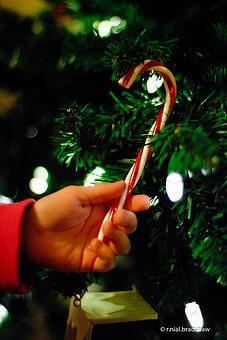 Candy canes are one of the most often seen symbols of the holidays with nearly 2 billion candy canes being sold in the four weeks leading up to Christmas and Hanukkah. We use them to adorn our trees, to decorate deserts and even place them in our drinks. While the candy cane is the most recognizable holiday symbol, it has an elusive history. There are many legends and lore of how the striped cane came to fame, but few have yet to be proven historically accurate.
Candy canes are one of the most often seen symbols of the holidays with nearly 2 billion candy canes being sold in the four weeks leading up to Christmas and Hanukkah. We use them to adorn our trees, to decorate deserts and even place them in our drinks. While the candy cane is the most recognizable holiday symbol, it has an elusive history. There are many legends and lore of how the striped cane came to fame, but few have yet to be proven historically accurate.
The candy cane dates back 350 years with the original being made of a hard white sugar stick with no curve. When the practice of using Christmas trees to celebrate became popular in Europe, the candy cane began its popularity as a decoration. The common decorations of the time were food and candy, thus the candy cane fit in perfectly.
Between the Europeans use of the candy cane in the 17th century and the Americans adaptation in the 19th century, there was little to be known of the hard candy - especially the creation of the hooked shape and the inclusion of the red and white stripes.The most common tale of how the crook came to be is that a choirmaster of the Cologne Cathedral persuaded a craftsman to bend the end of the sticks to represent a Sheppard's crook. He then passed the candy out to restless youngsters who were attending the living creche. The inclusion of the red stripes are even harder to place on a single person, however the creation date has been narrowed down. Christmas cards prior to the year 1900 showed only all-white candy canes, while Christmas cards after 1900 showed illustrations of striped candy canes.
It isn't till the 1920s, when a candymaker named Bob McCormack found the confections were difficult to mass-produce, that his company invented a machine (the Keller Machine) to speed up the process. Innovations as break-proof packaging and moisture-proof candy wrappers helped Bob's Candies become the world's leading candy cane producer before they sold the company in 2005.
While Candy canes adorn the Christmas tree, the Christmas stocking found its home above the fireplace, but why? The tale most widely referenced when speaking of the Christmas stocking is that of a widowed man and his three daughters. Though the daughters were blessed with beauty, the father feared that their impoverished state would keep his daughters from being wed. St. Nicholas heard of the father's plight and placed three gold bags into the daughters drying stocking which hung above the fireplace. From this tale a tradition was made.

- In France, the children place their shoes by the fireplace, a tradition dating back to when children wore wooden peasant shoes.
- In Holland, the children fill their shoes with hay and a carrot for the horse of Sintirklass.
- In Hungary, children shine their shoes before putting them near the door or a window sill.
- Italian children leave their shoes out the night before Epiphany, January 5, for La Befana the good witch.
- In Puerto Rico, children put greens and flowers in small boxes and place them under their beds for the camels of the Three Kings.
Whether you're hanging stockings above your chimney, lighting your menorah or cooking for Karamu, we at CoVest wish you a Happy holiday!
Images provided by Flickr users: r.nialbradshaw and DavidTelford



